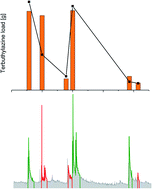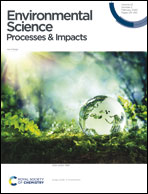Quantitative use of passive sampling data to derive a complete seasonal sequence of flood event loads: a case study for maize herbicides in Luxembourg†
Abstract
Pesticides are the class of compounds with the most dynamic behaviour in their surface water occurrence: their episodic release to surface waters is closely related to the date of application and the following weather conditions and poses substantial challenges to monitoring in order to yield accurate mass transfer figures. Moreover, pesticide use, dose and time of application are largely unknown catchment wide and pose an essential problem as to the realism and reliability of pesticide fate modelling as well as accurate farmer counselling. Spatially and temporally highly resolved monitoring establishing pesticide sources was logistically unthinkable until the advent of passive samplers which combine ease of deployment and continuous sampling. However, because research on passive sampler performance has been mainly driven by analytical precision issues, doubts were high as to whether passive samplers could yield accurate time weighted averages in the field, all the more so that the number of field validations is to this day very limited. Here we present a study that used a combination of spatially distributed passive- and autosamplers to capture the runoff dynamics of pesticides used for maize crops in a 82 km2 catchment in Luxembourg. We demonstrate that passive samplers are capable of accurately monitoring episodic emissions of pesticides through a longitudinal profile in a catchment, thus allowing the identification of pesticide source areas. Thanks to the time-proportional nature of the passive sampling it was furthermore possible to calculate event mean concentrations and loads which were behaving temporally according to the physico-chemical properties of the compounds and to the timing and extent of mobilising discharge.



 Please wait while we load your content...
Please wait while we load your content...